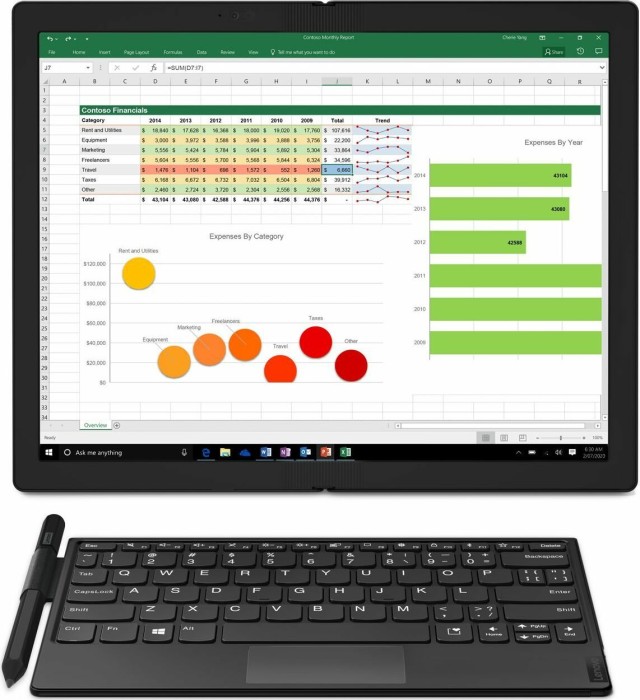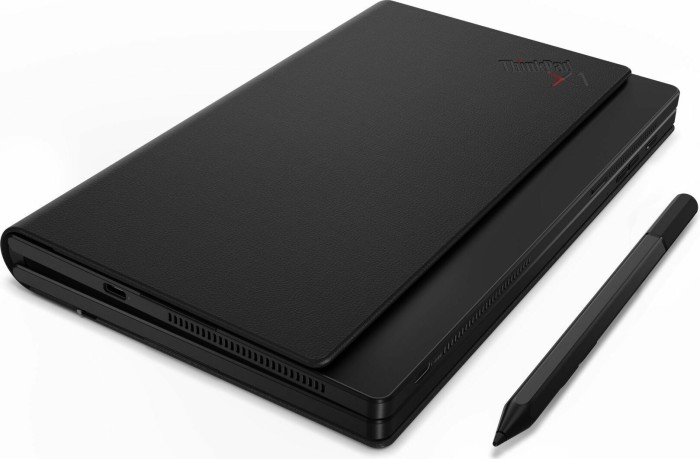Lenovo ThinkPad X1 Fold G1-20RL000GGE
Spécifications de l'ordinateur portable

Price comparison
Moyenne de 12 notes (à partir de 26 critiques)
Critiques pour le/la Lenovo ThinkPad X1 Fold G1-20RL000GGE
Source: MrMobile
 Archive.org version
Archive.org versionEver since I was six years old and watching Inspector Gadget, I’ve longed for a proper “computer book” – and the Lenovo X1 Fold gets closer to that dream than I ever thought possible. Its large folding display is the most rugged and crease-free I’ve ever used, and it works together with a cleverly designed wireless keyboard companion and beautiful leather shell to deliver a laptop experience like no other. Fully deployed, the Lenovo X1 Fold rests on its built-in kickstand to serve as a 13.3” laptop; or, fold the screen in half and slap on the magnetic keyboard for a more compact 7” netbook. Use it in easel mode as a stylus-equipped tablet; and when it’s time to pack it in for the day, it collapses into a footprint no bigger than a hardback novel.
Critique simple, disponibles en ligne, Longue, Date: 02/06/2021
Source: Tom's Guide
 EN→FR Archive.org version
EN→FR Archive.org versionInstead, you could get a similarly spec'd iPad Pro with Magic Keyboard and 2nd Gen Apple Pencil for $1,577, to get both a great tablet and laptop experience. And those who want a great Windows machine should just get the tried and true XPS 13, which is only $1,225 when similarly configured as the X1 Fold. Neither of those laptops have folding displays, but after writing this review, we know when to fold 'em, and when to walk away.
Critique simple, disponibles en ligne, Longue, Date: 02/02/2021
Notes: Note globale: 50%
Source: Mobile Syrup
 EN→FR Archive.org version
EN→FR Archive.org versionLenovo’s X1 Fold is an excellent first attempt, but I think most people would be better off waiting for a second generation Fold. In so many ways, the X1 Fold feels like the future. It’s versatile, you can bend and manipulate it to adapt to nearly any workflow. And yet, when I try to use it, it grinds my workflow to a crawl.
Critique simple, disponibles en ligne, Longue, Date: 01/27/2021
Notes: Note globale: 60%
Source: Techradar
 EN→FR Archive.org version
EN→FR Archive.org versionThe Lenovo ThinkPad X1 Fold is a remarkable and gorgeous innovation, but its very underwhelming performance and battery life makes it hard to recommend for the price.
Critique simple, disponibles en ligne, Longue, Date: 12/19/2020
Notes: Note globale: 60%
Source: Neowin
 EN→FR Archive.org version
EN→FR Archive.org versionThe Lenovo ThinkPad X1 Fold has just so many flaws, but boy do I love it. When I started using it, I immediately felt like this could be something great. It's just a delight. But then the bugs start to kick in. I started getting annoyed by the tiny keyboard, and a big frustration for me was that it didn't have cellular.
Critique simple, disponibles en ligne, Très longue, Date: 12/19/2020
Notes: Note globale: 60%
Source: The Verge
 EN→FR Archive.org version
EN→FR Archive.org versionThe key word there is “yet.” Because with all that being said, I can’t wait for the second generation. Samsung’s first foldable phones were riddled with issues — but just over a year and several iterations later, the company is selling a folding device that’s very usable (albeit pretty expensive). I’m sure that’s going to be the case with foldable laptops as well. Lenovo has a groundbreaking idea, with a strong foundation to build on. I really hope it’s able to patch the Fold’s glitches without compromising on the components that are already exceptional. That would be a breathtaking device, one that would earn my unambiguous recommendation.
Critique simple, disponibles en ligne, Très longue, Date: 12/15/2020
Notes: Note globale: 55%
Source: PC Mag
 EN→FR Archive.org version
EN→FR Archive.org versionLenovo's durable ThinkPad X1 Fold, with its detachable keyboard and revolutionary foldable screen, is the most futuristic Windows device of 2020—though far from the most practical one.
Critique simple, disponibles en ligne, De taille moyenne, Date: 12/09/2020
Notes: Note globale: 60%
Source: Engadget
 Archive.org version
Archive.org versionWe first got a look at Lenovo's Thinkpad X1 Fold last CES, and it certainly caught our attention. A giant tablet that folds in the middle like a book, and can be propped up with a kickstand, or folded in half and paired with a keyboard to transform it into a mini laptop. The technology on display is impressive, but the device is held back by it's software. It runs windows, which has always had problems as a tablet OS. It looks like the future, but buggy software, coupled with the sky-high price tag (starting over $2500), make it hard to recommend the X1 Fold.
Critique simple, disponibles en ligne, Longue, Date: 12/08/2020
Source: Engadget
 EN→FR Archive.org version
EN→FR Archive.org versionThe ThinkPad X1 Fold is an impressive piece of technology that sorely needs better execution. It’s laudable that Lenovo was able to make a 13.3-inch OLED tablet that can bend, but on its own the $2,600 Fold is a seriously expensive Windows tablet. Throw in the $230 keyboard that fits neatly between the screen’s two halves for a faux laptop mode and you get a neat mini machine that’s only good for quick emails and tweets. But few, if any, people should spend nearly $3,000 to buy the X1 Fold when any Surface tablet would serve you far better.
Critique simple, disponibles en ligne, De taille moyenne, Date: 12/08/2020
Notes: Note globale: 64%
Source: Laptop Mag
 EN→FR Archive.org version
EN→FR Archive.org versionGiven these gripes, the ThinkPad X1 Fold isn't practical for most people. Rather, it's a device I can see CEOs flaunting in board meetings. And the few people who do buy this PC will probably really enjoy using it. Throughout my time with the X1 Fold, I struggled to answer the question: "Does this even work as a concept?" Well, the growing dread I feel about having to ship this back to Lenovo says a lot, and I'm eager to see what comes next.
Critique simple, disponibles en ligne, Très longue, Date: 12/06/2020
Notes: Note globale: 60%
Source: Laptop Mag
 EN→FR Archive.org version
EN→FR Archive.org versionThis was always going to be a tough product to judge. I really like having the ThinkPad X1 Fold around. Its small form factor doesn't take up much space and the gorgeous OLED panel beautifully showcased my favorite shows and movies. Also, the excellent build quality, crafted with a mix of high-end materials, earns Lenovo some hearty applause.
Critique simple, disponibles en ligne, Très longue, Date: 12/06/2020
Notes: Note globale: 60%
Source: Laptop Media
 Archive.org version
Archive.org versionSoutien, disponibles en ligne, De taille moyenne, Date: 12/04/2020
Source: Laptop Media
 EN→FR Archive.org version
EN→FR Archive.org versionYou don’t get to see such machines often. Before we wrap this review up, we have to say that it is a remarkable device, and we want to praise Lenovo for having the balls to make it. However, with every Gen 1 product, you should expect some minor issues that need taking care of. The first one here is the performance. This is not a powerhouse. You won’t be able to edit your videos or play the latest AAA titles. Accept it. However, you can do a ton more stuff. By the way, we had an early sample from Lenovo, so the performance might be better on a retail unit.
Critique simple, disponibles en ligne, Très longue, Date: 12/03/2020
Source: Mobile Tech Review
 Archive.org version
Archive.org versionLisa Gade reviews the Lenovo ThinkPad X1 Fold, the first Windows 10 tablet / convertible laptop with a flexible OLED display. The X1 Fold has a 13.3” OLED display with a 4:3 aspect ratio that can fold to a book-like posture or it can be used like a chassis laptop thanks to Lenovo’s magnetically attached wireless keyboard. The tablet also works with the Lenovo Mod Pen, which is a first for active pens on flexible displays. The Fold has an Intel Lakefield 5-core processor, 8GB RAM and your choice of 256GB-1TB PCIe SSD storage. It has a Windows Hello IR camera, 5MP front camera and is wrapped in a leather cover that doubles as a kickstand.
Critique simple, disponibles en ligne, Très longue, Date: 12/03/2020
Source: Neowin
 Archive.org version
Archive.org versionUnboxing the world's first PC with a foldable screen, the Lenovo ThinkPadX1 Fold.
Travaux pratiques, disponibles en ligne, Très longue, Date: 11/28/2020
Source: PC Welt
 DE→FR Archive.org version
DE→FR Archive.org versionCritique simple, disponibles en ligne, Longue, Date: 02/23/2021
Notes: Note globale: 80% performances: 71% équipement: 70% écran: 86% mobilité: 69% ergonomie: 82% degré de nuisance: 100%
Source: Golem
 DE→FR Archive.org version
DE→FR Archive.org versionCritique simple, disponibles en ligne, Longue, Date: 12/28/2020
Source: Onlinekosten.de
 DE→FR Archive.org version
DE→FR Archive.org versionCritique simple, disponibles en ligne, De taille moyenne, Date: 12/22/2020
Source: Spiegel Online
 DE→FR Archive.org version
DE→FR Archive.org versionCritique simple, disponibles en ligne, Longue, Date: 12/05/2020
Source: Xataka
 ES→FR Archive.org version
ES→FR Archive.org versionCritique simple, disponibles en ligne, Très longue, Date: 02/08/2021
Notes: Note globale: 83% performances: 80% écran: 90% mobilité: 78% finition: 90% ergonomie: 80%
Source: Komputerswiat
 PL→FR Archive.org version
PL→FR Archive.org versionCritique simple, disponibles en ligne, Courte, Date: 12/20/2020
Source: Chip Online TR
 TR→FR Archive.org version
TR→FR Archive.org versionCritique simple, disponibles en ligne, De taille moyenne, Date: 04/01/2021
Notes: Note globale: 80%
Source: 3DNews.ru
 RU→FR Archive.org version
RU→FR Archive.org versionCritique simple, disponibles en ligne, Très longue, Date: 04/19/2021
Source: Hi-Tech Mail
 RU→FR Archive.org version
RU→FR Archive.org versionCritique simple, disponibles en ligne, Longue, Date: 02/05/2021
Source: Pemmzchannel
 ID→FR Archive.org version
ID→FR Archive.org versionCritique simple, disponibles en ligne, Courte, Date: 12/07/2020
Source: Go4it.ro
 →FR Archive.org version
→FR Archive.org versionCritique simple, disponibles en ligne, Courte, Date: 09/30/2020
Commentaire
Intel UHD Graphics G7 (Lakefield GT2 64 EU):
Carte graphique intégrée dans les SoCs Intel Lakefield G7 basés sur la nouvelle architecture Gen. 11 avec 64 EUs (Execution Units / Shader Cluster). Similaire à l'Iris Plus G7 dans les processeurs Ice Lake, mais avec une vitesse d'horloge beaucoup plus faible de seulement 200 - 500 MHz et donc seulement performant au niveau de l'Intel UHD Graphics 620. Les puces Lakefield sont produites selon le processus moderne de 10 nm chez Intel.
Ces cartes devraient être capables de faire tourner tout les jeux d'aujourd'hui, mais la plupart d'entre eux uniquement en détails moyens ou faibles et avec des résolution basses. Les plus vieux jeux ou les jeux moins gourmands restent jouables avec de beaux graphismes.
>> Plus d'informations sont à trouver dans notre comparaison des cartes graphiques mobiles et ainsi que dans notre liste des Benchmarks affiliés.
i5-L16G7: Le Core i5-L16G7 est un SoC avec 5 cœurs de processeur basé sur l'architecture Lakefield. Il utilise un cœur rapide Sunny Cove (connu des processeurs Ice Lake) avec une fréquence allant jusqu'à 3 GHz et 4 petits cœurs Tremont (Atom / Celeron). Le CPU ne supporte pas l'HyperThreading / SMT. Le reste du SoC est similaire aux puces Ice Lake, comme la carte graphique Gen 11 avec 64 EU (Iris Plus G7). Le SoC est fabriqué en 10nm.
>> Plus d'informations sont à trouver dans notre comparaison des processeurs mobiles.






